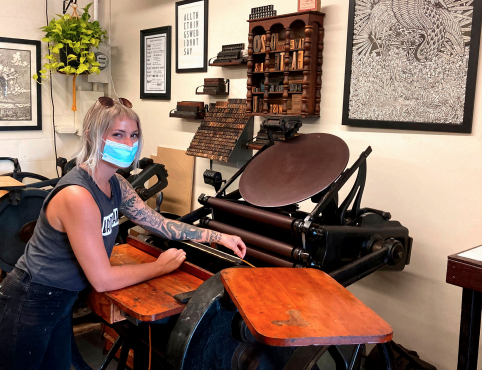In early October, a self-proclaimed “weirdo” and printmaking devotee opened Labyrinth Studios – a gallery, printshop and creative learning space to introduce interdisciplinary arts – in south Seminole Heights. It is open to any skill-level to teach technical, creative and magical thinking, said Ali Norman, Tampa-raised University of Tampa adjunct professor of art and business owner.
UT’s Art Department approved internship credits for students who work at Labyrinth Studios. She has a running list of goals with an emphasis on the local Tampa community. Norman said she has “little hamsters in wheels” running in her head, and she knows all her goals really well. She can’t keep the same notebook for more than two weeks.
She uses the notes in her phone, “but it’s like incoherent single word lists. Just random ideas,” Norman said. “Then when I look back, I’m like, ‘What does strawberry train mean?’”
Norman said she is not teaching at UT this semester since art classes aren’t functioning as normal due to the pandemic, but plans to come back next semester if she feels that it’s safe. She used her time off to open Labyrinth Studios, which had been in progress for three years.
Norman didn’t know exactly what kind of artist she wanted to be when she was an undergraduate at Savannah College of Art and Design (SCAD), and she didn’t know what to expect when she took her first printmaking class. But, she fell in love.
“I’m fully committed to the print life. This is my bread and butter,” said Norman. Printmaking extends to her wardrobe; if she wears any other color than black, she stains her clothes.
Printmaking is an overarching term for the artistic process of transferring images from a matrix onto another surface. The art technique originated in the Medieval Era, and she explained how there are centuries-worth of experimentation with the medium since it’s conception. Norman described the art as “so many things to do, and everyone does it a little bit differently.”
Imagine a leaf. Roll that leaf in ink, and press it onto a paper. The leaf would be the matrix. A printmaker can roll ink onto any matrix (leaves, copper, or a silkscreen), and then pressed onto paper (and other surfaces) to create multiple copies of the design.
Norman recommends scientific-thinking people for printmaking. She explained there are chemical and mathematical depths behind copper etching – half of the art medium is executing chemical processes. She said a lot of technical thinking people become printmakers because you get to be creative but you get to experiment.
“As much as you can hear someone explain it [intaglio], you won’t get it until you do it,” Eliza Cohen, junior art major with a concentration in printmaking. Cohen works as an intern for Labyrinth.
Norman specializes in intaglio, a technique of printmaking that utilizes engraving or etching with a copper matrix. She described intaglio as “printing stuff the traditional way,” with vintage printing presses, oil based inks, and chemicals everywhere. Norman says her craft brings her closer to the earth given the intaglio’s rich history and connection to the planet. She works with natural materials like oil grease, wood and her matrix of choice: copper.
She remains open-minded to any creative outcome, referring to herself as an “open channel.” She didn’t understand every idea she executed when she first started.
Art and magic are “completely inseparable” according to Norman. The process of printmaking is ritualistic; the artist does a lot of repetitive movements, does the steps in a specific order, and it results in the changing of chemical properties. These are similar to old occult practices. “We’re also transforming a part of ourselves by interacting with the process.”
She discovered occult practices while attending SCAD. Since implementing magical thinking in her craft, her current connection to herself, her art and magic is “more elevated,” she said. She learned to balance her personal intentions with the natural flow of artmaking.
Norman’s Intaglio students spoke about printmaking with the same excitement. Senior art major Ian Kenney shortly picked up the printmaking concentration after taking Norman’s Intaglio I class.
“I think [enthusiasm is] a major factor in how she gets everyone dedicated to projects. Even students who came into intaglio having no idea what it was,” Kenney said. He explained Norman focused more on technique and gave students open artistic liberty. Kenney hand-painted the Labyrinth’s signage on the front of the building.
She gives a tarot card project as her first project for her Intaglio class to introduce them to “casual magic.” The goal is to provoke deep thought about the symbolism behind the art, and how the artist can connect to their creations.
“Magic is all around you. You just have to be open to perceiving it,” said Norman.
Norman has taught art at UT for over two years now, including Drawing I, Digital Painting, Intaglio I and Intaglio II, and Design. It’s her first teaching job outside of teaching a printmaking course part-time during grad school. Head of the Printmaking department and assistant professor of art and design Ry McCollough went to grad school with Norman, and kept her in mind when a teaching position opened at UT.
“In a decade, I haven’t really had the opportunity to live in my hometown, so I kind of jumped on that.” After finishing at University of Georgia Athens and before moving back to Tampa, Norman had mostly worked in various print shops and art residencies around Georgia, New England and New York. She had a tattoo apprenticeship at one point.
One of her many tattoos includes Renaissance artist Albrecht Dürer’s signature on her wrist. Dürer set the precedent for modern copper etching, Norman explained, and credited the artist for fueling her experimentation, visual inspiration and physical technique. Once as an undergraduate, she used a printmaking process called “soft-ground etching” and attempted to make an impression out of roadkill. Another time, she cut off six inches of her own hair. Neither experiment succeeded.
“It’s always a pleasure to come into the studio and see her student’s work… because if it were just me, I would only be able to see the things I’m doing and what my students are doing,” said McCollough. “To have that diverse perspective makes the studio so much more rich… This is kind of everything that I wanted to happen [for the department].”
While explaining her teaching process, Norman used the word “transmute” multiple times, meaning the action of transforming the state of being into another form. When Googling it, you can filter the definition in: physics, chemistry, biology, and occult. Does that sound familiar?
Upcoming events at Labyrinth include a Halloween workshop to create talismans, from 7 p.m. to 11 p.m. There will be sound bowl healings and tarot card readings with the owner of Royal Suzie, a spiritual crystal shop in the same plaza.
It used to be that people needed to be inside that metropolitan art hub to get recognition as an emerging artist, according to Norman. Today, artists use social media to spread their name. Teaching part-time allowed her to work on her own projects, but Norman’s career evolved while maintaining a high social media following. She started earning half of her income posting “how-to” videos on her Instagram, @AliNormanPrints. Earning money online meant she could have time to teach a couple classes while working on personal projects.
She called herself an educational “influencer”. “I just think it means I have a lot of followers… It’s a very niche, nerdy printmaking following. They want to know like, ‘Hey, what acid did you use for this and for how long does it soak for?’”
Norman wants to keep art accessible among the pandemic. She’s working on a Patreon where she wants to offer full-length classes to inform the public about non-toxic processes that wouldn’t harm you or your house. She has variousexperiences from working at home andlearning how to print safely.
Norman advised to message other artists online and start dialogue with people you admire. Ask for tips and form bonds. Usually, she messages people online and asks for advice, and artists usually reply to her. She calls it a karmic exchange: you get what you give.
On top of Labyrinth Studio getting steady online traffic, many vintage equipment was donated to her by a widower, junkyards, and a retired print shop. Norman describes the opening of her studio as “synchronistic” or “divine intervention.”
“That’s one way to put it – that it all just worked out; but, it’s really Ali’s tenacity and vision that made it happen. I want to make sure we honor all of that hard work,” said McCollough.
Norman said that printmaking is a “lifelong thing” with so many things to create and so many ways to do it. “People consider me like a master, and I’m like, ‘huh?’ I will probably be 60 and I still won’t be a master. There’s still things to learn.”




